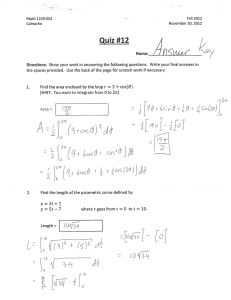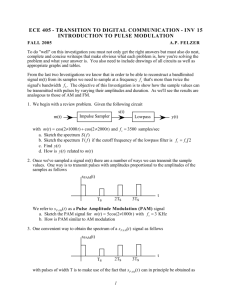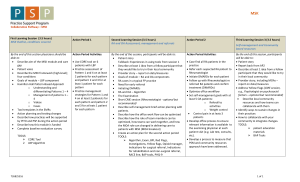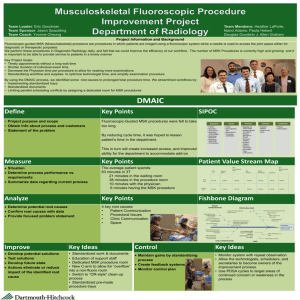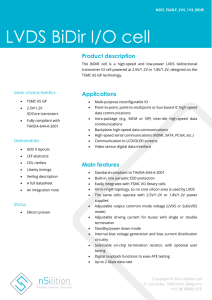More on MSK MSK is a Linear Modulation Recall BFSK ∑ The
advertisement
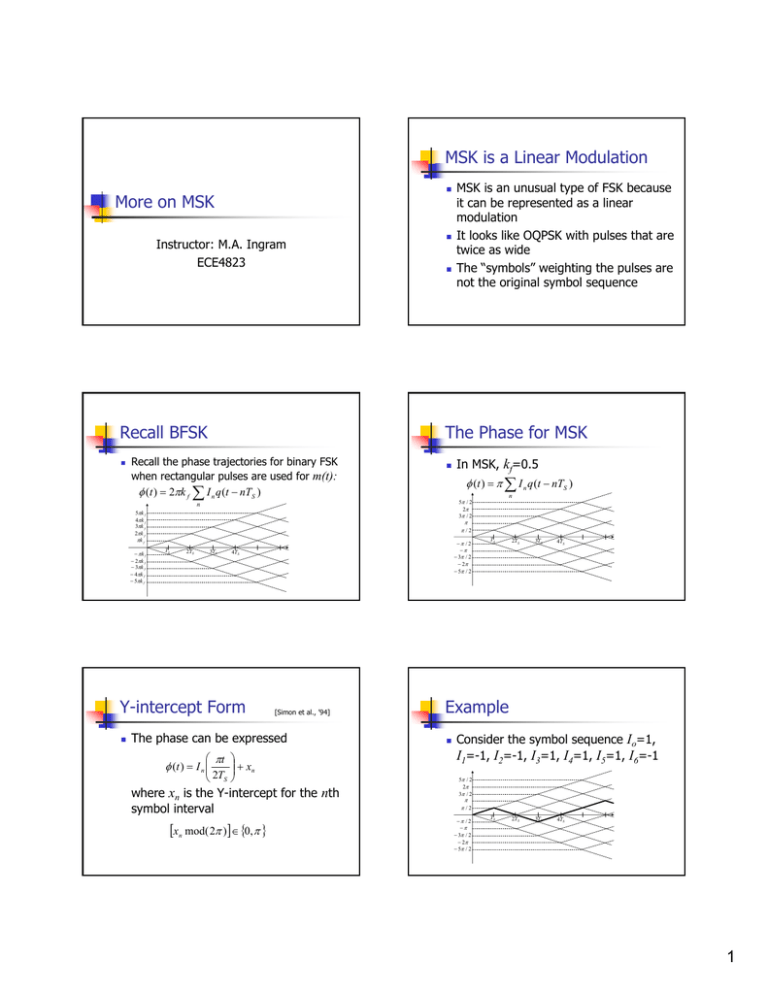
MSK is a Linear Modulation
More on MSK
Instructor: M.A. Ingram
ECE4823
Recall BFSK
The Phase for MSK
Recall the phase trajectories for binary FSK
when rectangular pulses are used for m(t):
φ (t ) = 2πk f ∑ I n q (t − nTS )
φ (t ) = π ∑ I n q (t − nTS )
n
n
π
π /2
TS
2TS
3TS
−π / 2
−π
− 3π / 2
− 2π
− 5π / 2
4TS
Y-intercept Form
In MSK, kf=0.5
5π / 2
2π
3π / 2
5πk f
4π k f
3πk f
2πk f
πk f
− πk f
− 2πk f
− 3πk f
− 4πk f
− 5πk f
MSK is an unusual type of FSK because
it can be represented as a linear
modulation
It looks like OQPSK with pulses that are
twice as wide
The “symbols” weighting the pulses are
not the original symbol sequence
[Simon et al., ’94]
The phase can be expressed
πt
φ (t ) = I n
2TS
+ xn
where xn is the Y-intercept for the nth
symbol interval
[xn mod( 2π )]∈ {0, π }
TS
2TS
3TS
4TS
Example
Consider the symbol sequence Io=1,
I1=-1, I2=-1, I3=1, I4=1, I5=1, I6=-1
5π / 2
2π
3π / 2
π
π /2
−π / 2
−π
− 3π / 2
− 2π
− 5π / 2
TS
2TS
3TS
4TS
1
For Io=1 and 0<t<TS
πt
2TS
φ (t ) = I 0
πt
+ x0 = 1 ⋅
2TS
For I1=-1 and TS<t<2TS
+ 0
x0 = 0
5π / 2
2π
3π / 2
2TS
3TS
4TS
πt
+ x2 = −1 ⋅
2TS
πt
2TS
φ (t ) = I 2
+ π
x2 = π
2TS
3TS
4TS
πt
2TS
φ (t ) = I 3
πt
+ x3 = 1 ⋅
2TS
− 2π
x3 = −2π
=0
5π / 2
2π
3π / 2
π
π /2
TS
2TS
3TS
4TS
−π / 2
−π
− 3π / 2
− 2π
− 5π / 2
I/Q Formulation of MSK
It can be shown that
where
x1 = π
For I3=1 and 3TS<t<4TS
π
π /2
s (t ) =
TS
−π / 2
−π
− 3π / 2
− 2π
− 5π / 2
5π / 2
2π
3π / 2
+ π
π
π /2
TS
For I2=-1 and 2TS<t<3TS
−π / 2
−π
− 3π / 2
− 2π
− 5π / 2
πt
+ x1 = −1 ⋅
2TS
5π / 2
2π
3π / 2
π
π /2
−π / 2
−π
− 3π / 2
− 2π
− 5π / 2
πt
2TS
φ (t ) = I1
2ε b
∑ cn p (t − ( 2n − 1)TS ) cos (2πf c t )
TS n
− ∑ d n p (t − 2 nTS ) sin (2πf c t )
n
πt
sin
p (t ) = 2TS
0
0 ≤ t ≤ 2TS
otherwise
c n = (− 1) cos x 2 n −1
n
d n = (− 1) I 2 n cos x 2 n
n
TS
2TS
3TS
4TS
Example, cont’d
n
In
0
1
xnmod2π cosxn
0
cn
1
-1
π
-1
2
-1
π
-1
3
1
0
1
4
1
0
1
5
1
0
1
6
-1
0
1
dn
d0=1
1
c1=1
d1=-1
c2=1
d2=1
c3=-1
d3=1
2
Baseband Waveform for the
Example
c1 = 1
c3 = − 1
c2 = 1
MSK Resembles OQPSK
I
The basic pulse shape is half a sinusoid
that is 2TS wide
t
TS
2TS
3TS
4TS
5TS
6TS
7TS
c1 = 1
c3 = 1
c2 = 1
I
d0 = 1
d1 = − 1
d3 = 1
d2 = 1
TS
2T S
3T S
Q
2TS
3TS
4TS
5TS
6TS
The MSK receiver can be implemented
coherently like an OQPSK receiver
( 2 n +1)TS
r(t)
2 n −1)TS
(• )dt
( 2 n + 2 ) TS
∫(
πt
sin
2TS
2 n )TS
Logic
Circuit
(• )dt
t
d4 = 1
Decision
Circuit
2T S
3T S
4T S
5T S
6TS
7T S
Summary
Decision
Circuit
πt
cos (2πf c t )
cos
2TS
7T S
t
Quadrature Detection
∫(
6TS
Q
7TS
TS
5T S
d3 = 1
d 2 = −1
d1 = 1
t
TS
4T S
MSK is actually a linear modulation
method
The basic pulse shape is half a sinusoid
that is two bit periods wide
Resembles OQPSK with this basic pulse
shape
sin (2π f c t )
References
[Rapp, ’02] T.S. Rappaport, Wireless
Communications, Prentice Hall, 2002
[Simon et al., ’94] M.K. Simon, S.M.
Hinedi and W.C. Lindsey, Digital
Communication Techniques, Signal
Design and Detection, PTR Prentice
Hall, 1994.
3
